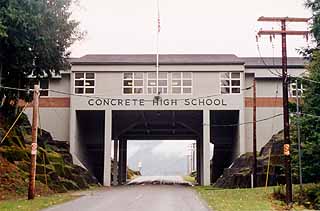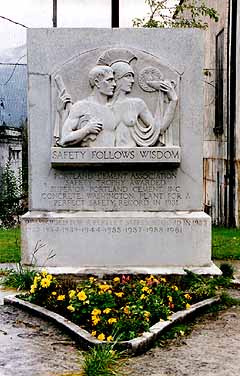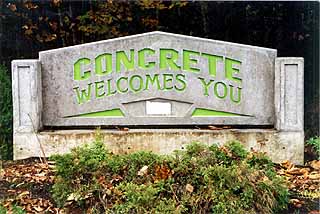 |
June 3, 2005
Skagit County town's history is rich in Concrete
WACA

Photos by Bruce Chattin
Most public buildings in the town of Concrete are made of concrete, including the CMU block high school.
|
Located along the Cascades in Skagit County is a town known more for its fine fishing and deer hunting than its role in helping build much of Washington.
The town of Concrete is like any small community located far from the hustle and bustle of metropolitan cities. Life is slower, everyone knows your name and Friday night high school football games play to a faithful crowd.
But this town has a unique story, a connection to building those metropolitan cities, and it's all centered on cement and concrete. Founded on a deposit of limestone and clay, the town about a century ago became home to the state's first Portland cement production facility.
| Award winning rehab |
|
The town of Concrete has won the 2005 Concrete Community Award from the Washington Aggregates and Concrete Association for its use of concrete in its recent rehabilitation of Main Street.
|
The Washington Portland Cement Co. started building the town's first plant on June 1, 1905, and produced cement in May 1907.
Growth, led by the Hiram M. Chittenden Locks project near Seattle, soon made a second cement plant necessary.
The second plant was built by Superior Cement, which began making Portland cement there in 1908. The Superior plant used the traditional dry production process, but converted in 1917 to the more efficient wet slurry process.
In 1918, Superior Cement bought Washington Portland Cement.

A memorial stands in town to recognize past years of perfect safety at the Superior Portland Cement plant.
|
At its peak, there were six kilns operating with a combined capacity of 5,200 barrels per day, each powered by subbituminous coal delivered by rail from the Bellingham Coal Co. Limestone was first transported from the quarry to the mill by a 2-mile railway and, sometime before 1930, converted to an aerial tramway with a capacity of 260 tons per hour.
The operations typically employed 160, but up to 200 worked at peak capacity. With a population of 1,000 in 1930, it wasn't hard to figure out Portland cement was at the core of this town.
The original plant continued under the operation of Lone Star Cement until 1967 and the business office remained in operation until 1973, when the plant formally shut down. Modern technology made both of the aging plants impractical to operate.
The town of Concrete's history goes back to 1871, when pioneers settled on the banks of the Baker River. In 1890, a year after Washington became a state, the town was officially platted and began to grow under the name of Baker.
Across the river, the new Washington Portland Cement settlement grew and became to be known as Cement City. The town took on the personality and ownership of its core industry.
Story has it Star Cement was a brand name of one of the cement companies and each town was nicknamed a brand of cement, such as "Star City" or generically "Cement City." In 1909, after much debate, the Baker community settled on the name of Concrete.

Visitors are welcomed to town by a concrete sign.
|
As you walk along Main Street, a short section of town that still houses the original structures, there was another reason why this town took on the name of Concrete. On or before 1920, the town or parts of it burned down, possibly twice. Town folk turned to concrete after the last fire.
Today, the liquor store and bank building proudly display when they were last rebuilt — with concrete.
Although the limestone giants have come and gone, the town of Concrete recalls its origins: As you enter town, solitary silos proclaim "Welcome to Concrete" in wording that is still faintly visible. Visitors also are greeted by the open space surrounding the silos known as Silo Park, signs posted near the old cement plant remnants known as Superior Row, and the historic business office and safety sculpture.
Lone Star, now Glacier Northwest, still plays a role in the small community. The company has made improvements to Silo Park and provides tours of the state's first cement facility for its customers.
In its prime, a company club was available to plant visitors. The club featured a chef and included dining quarters and cottages. Glacier Northwest still hosts customers at the legendary Clinker Club after a day of guided salmon fishing on the Skagit River.
So if you are ever driving west outside of Sedro-Woolley on Highway 20, slow down to 20 mph as you enter the town of Concrete. If you can, catch a Friday night football game or a burger at the drive-in.
This little town is an integral part of our local history. A history that has helped build and shape the future of the Puget Sound area — all based on Portland cement and concrete.
Bruce Chattin is executive director of the Washington Aggregates & Concrete Association in Des Moines.
Other Stories:
- Is your mine ready for an extreme makeover?
- Special concrete weighs in locally
- Pump up your concrete strength with slag
